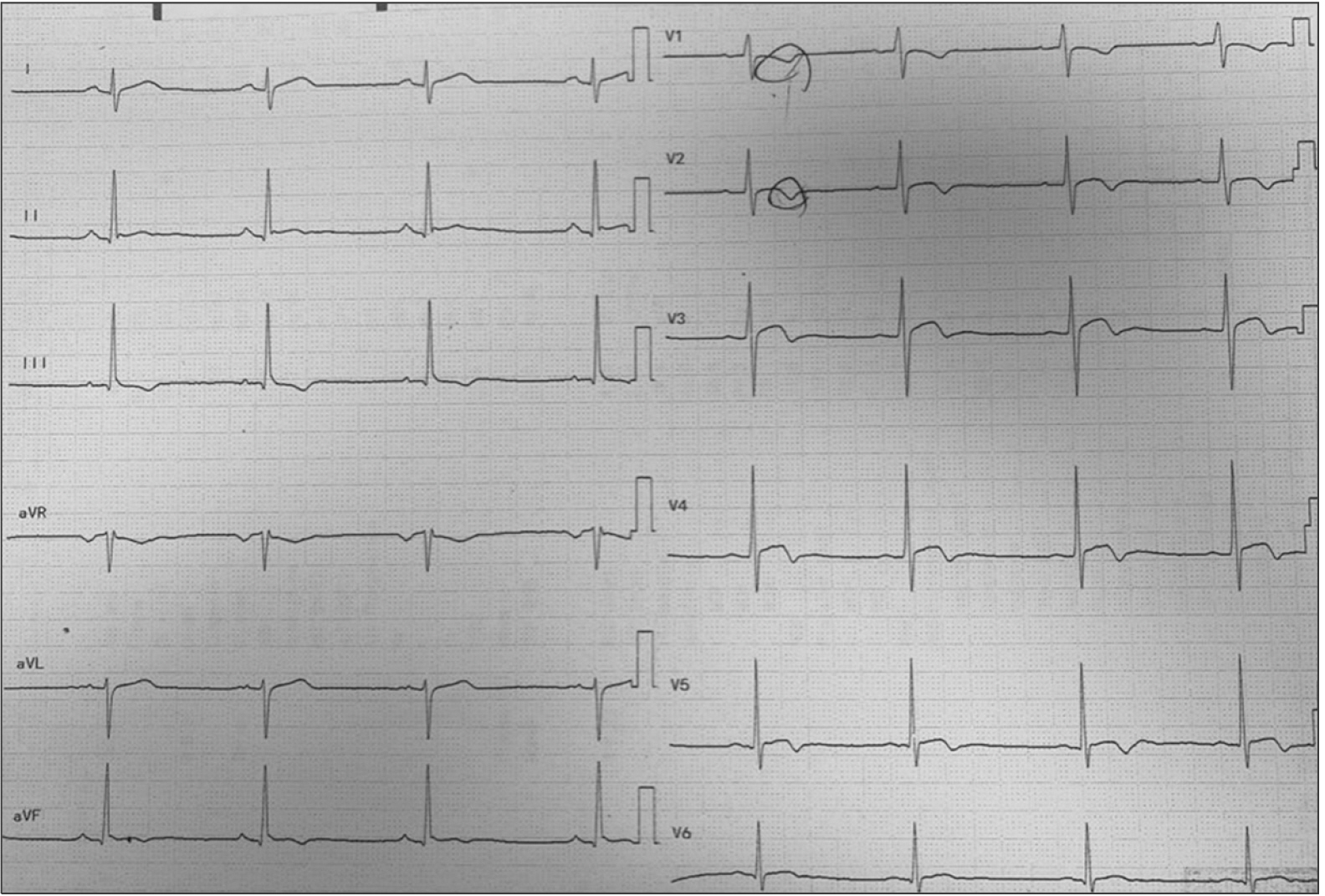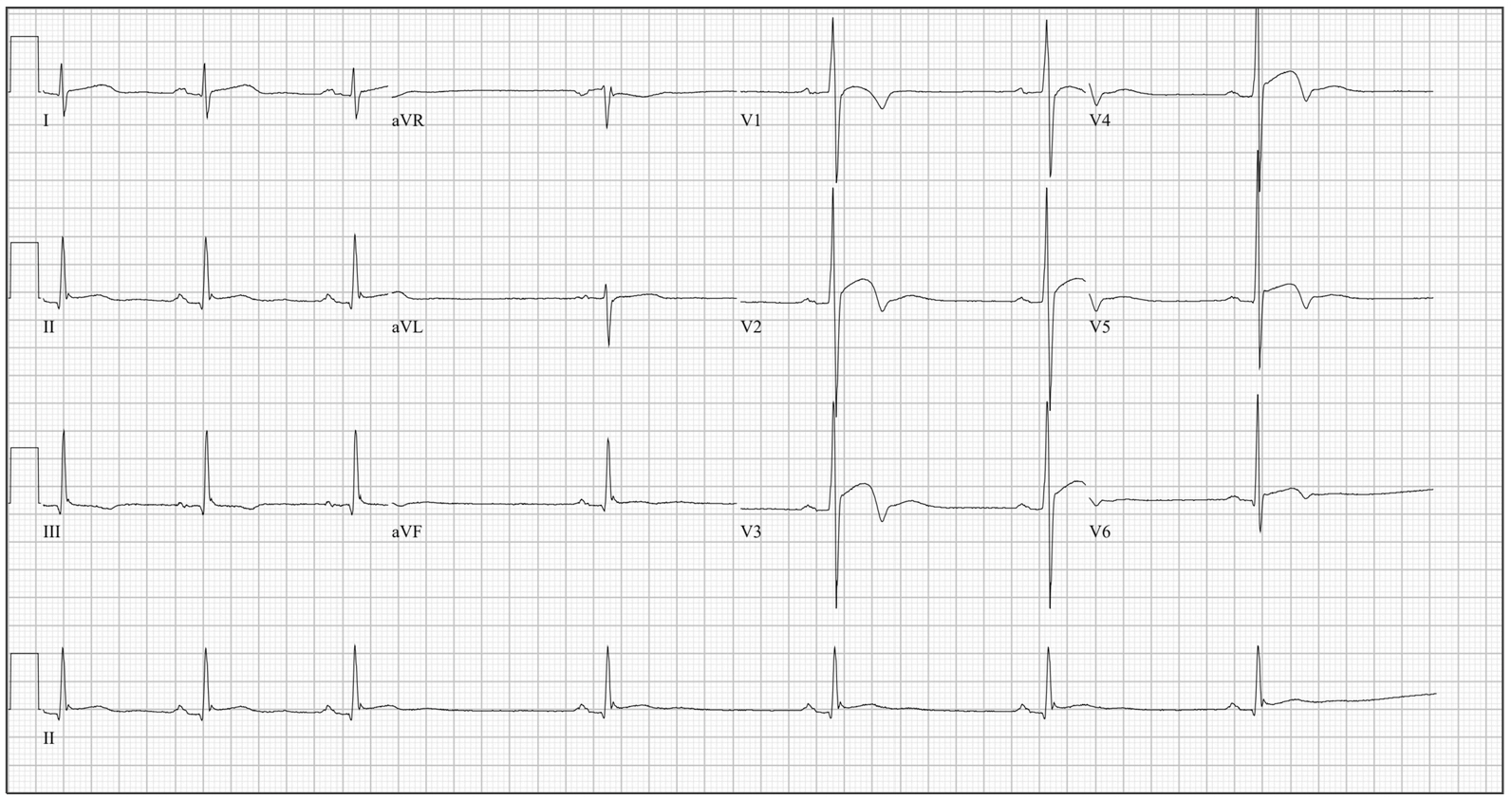Korean J Sports Med.
2021 Sep;39(3):131-134. 10.5763/kjsm.2021.39.3.131.
Electrocardiographic Abnormalities following Syncope during Warm-up in a Professional Football Player: A Case Report
- Affiliations
-
- 1Department of Orthopedic Surgery, Ulsan University Hospital, University of Ulsan College of Medicine, Ulsan, Korea
- KMID: 2519576
- DOI: http://doi.org/10.5763/kjsm.2021.39.3.131
Abstract
- We describe the case of a 32-year-old male professional football player experiencing syncope during a warm-up ahead of a regular professional football league match. Syncope recovered spontaneously, but an electrocardiogram test revealed T-wave inversion and upward convex ST elevation. Subsequent echocardiogram, angiography, exercise stress test, cardiac magnetic resonance imaging, and gene analysis showed no abnormalities. The athlete had no recurrence of chest pain or syncope during the treatment period of about 4 weeks, and there was no recurrence of symptoms until 6 months after returning to sports.
Keyword
Figure
Reference
-
1. Brignole M, Moya A, de Lange FJ, et al. 2018; 2018 ESC Guidelines for the diagnosis and management of syncope. Eur Heart J. 39:1883–948. DOI: 10.1093/eurheartj/ehy037. PMID: 29562304.2. D'Ascenzi F, Zorzi A, Sciaccaluga C, Berrettini U, Mondillo S, Brignole M. 2020; Syncope in the young adult and in the athlete: causes and clinical work-up to exclude a life- threatening cardiac disease. J Cardiovasc Transl Res. 13:322–30. DOI: 10.1007/s12265-020-09989-0. PMID: 32198700.3. Chandra N, Bastiaenen R, Papadakis M, Sharma S. 2013; Sudden cardiac death in young athletes: practical challenges and diagnostic dilemmas. J Am Coll Cardiol. 61:1027–40. DOI: 10.1016/j.jacc.2012.08.1032. PMID: 23473408.4. Vettor G, Zorzi A, Basso C, Thiene G, Corrado D. 2015; Syncope as a warning symptom of sudden cardiac death in athletes. Cardiol Clin. 33:423–32. DOI: 10.1016/j.ccl.2015.04.010. PMID: 26115828.
Article5. Sims DB, Sperling LS. 2005; Images in cardiovascular medicine: ST-segment elevation resulting from hyperkalemia. Circulation. 111:e295–6. DOI: 10.1161/01.CIR.0000165127.41028.D1. PMID: 15897351.6. Walsh JA 3rd, Prineas R, Soliman EZ, et al. 2013; Association of isolated minor non-specific ST-segment and T-wave abnormalities with subclinical atherosclerosis in a middle-aged, biracial population: Coronary Artery Risk Development in Young Adults (CARDIA) study. Eur J Prev Cardiol. 20:1035–41. DOI: 10.1177/2047487312460017. PMID: 22952292. PMCID: PMC4912353.
Article7. Stein R, Malhotra A. 2015; T wave inversions in athletes: a variety of scenarios. J Electrocardiol. 48:415–9. DOI: 10.1016/j.jelectrocard.2015.01.011. PMID: 25757937.
Article8. Miner B, Grigg WS, Hart EH. 2021. Wellens syndrome [Internet]. StatPearls Publishing;Treasure Island, FL: Available from: http://www.ncbi.nlm.nih.gov/books/NBK482490/. cited 2021 Apr 19.9. Malhotra A, Dhutia H, Gati S, et al. 2017; Anterior T-wave inversion in young White athletes and nonathletes: prevalence and significance. J Am Coll Cardiol. 69:1–9. DOI: 10.1016/j.jacc.2016.10.044. PMID: 28057231.10. Bianco M, Bria S, Gianfelici A, Sanna N, Palmieri V, Zeppilli P. 2001; Does early repolarization in the athlete have analogies with the Brugada syndrome? Eur Heart J. 22:504–10. DOI: 10.1053/euhj.2000.2247. PMID: 11237546.
Article
- Full Text Links
- Actions
-
Cited
- CITED
-
- Close
- Share
- Similar articles
-
- Acute Infrapatellar Fat Pad Injury after Non-contact, Hyperflexion Injury in a Professional Football Player: A Case Report
- Traumatic Pseudoaneurysm Related to Calcified Nodules of Cerebral Convexity Dura Mater in an American College Football Player
- A Study on Video Analysis of Sports Injuries and Management in Korean Professional Football
- Dementia Pugilistica with Clinical Features of Frontotemporal Dementia and Parkinsonism: Case Report
- The Comparative Study on the Supplement Use Habits of Korean Professional Soccer Players and Non-Athletic Males



